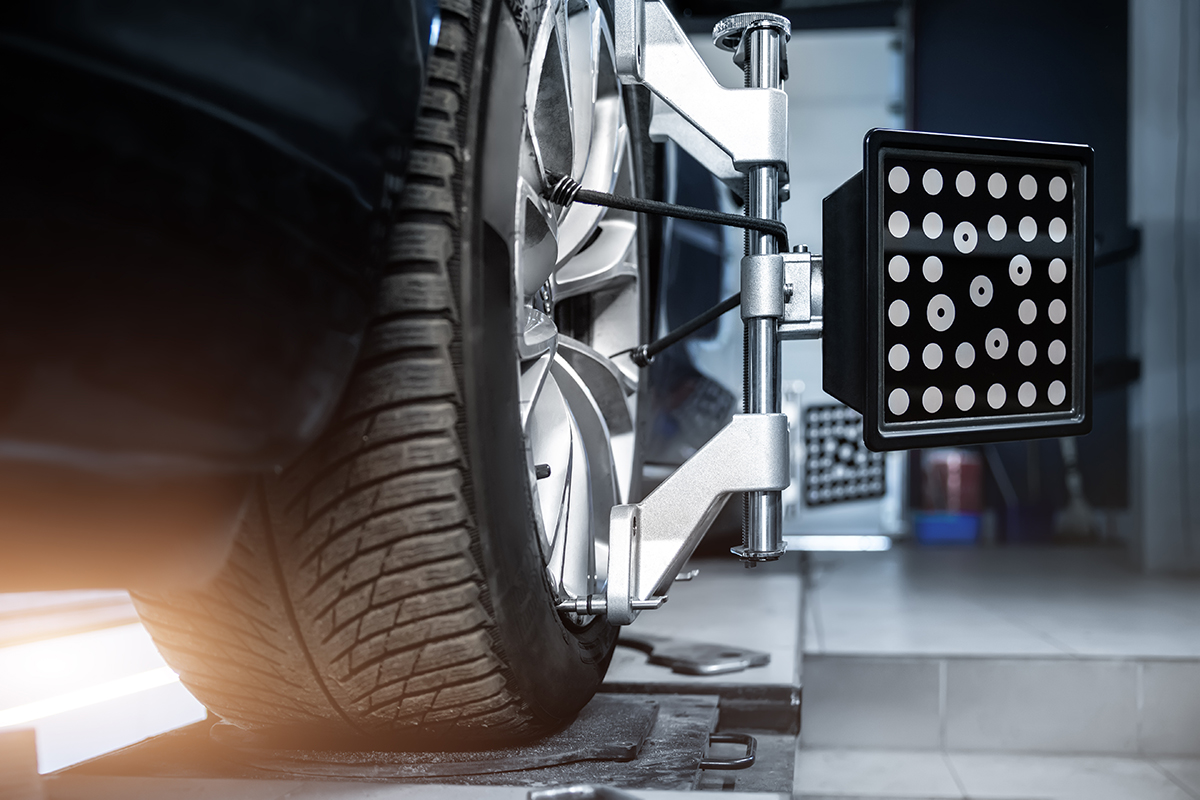Accurately monitor your surroundings, continuously.
Modern vehicles are smarter and safer than ever, thanks to Advanced Driver Assistance Systems (ADAS). These systems include features like lane departure warnings, adaptive cruise control, automatic emergency braking, and more. They rely on a network of sophisticated sensors – radar, cameras, LiDAR, and more – that constantly monitor your surroundings to help prevent accidents.
But here’s the catch: these systems only work properly when they’re correctly calibrated.
Even a minor bump, fender bender, or part replacement, like a new windshield or bumper, can throw off a sensor’s alignment. That’s why ADAS calibration is a critical service after many types of repairs, and why the collision center at Metro Motor offers ADAS calibration for vehicles in our care.

Image: ADAS calibration equipment is mounted to a vehicle wheel for testing.
What is ADAS calibration?
ADAS calibration is the process of precisely aligning the sensors and cameras in your vehicle’s safety system. These sensors need to “know” exactly where they are in relation to the road and your vehicle in order to make accurate split-second decisions.
According to experts like AAA and the Insurance Institute for Highway Safety (IIHS), even a sensor misaligned by just a fraction of a degree can result in significant errors down the road. That means your car’s safety systems may not activate when you need them most unless those sensors are recalibrated correctly. When is ADAS calibration needed? You may need ADAS calibration after:
- A collision, even a minor one
- Windshield replacement
- Bumper or grille repair or replacement
- Wheel alignment or suspension work
- Airbag deployment
- Replacing or moving any sensor-equipped parts
Many drivers are unaware that these common repairs can affect ADAS performance. Worse, not all ADAS sensors can alert you when they’re out of alignment, which is why it's critical to turn to a qualified collision repair shop like Metro Motor to inspect, test, and calibrate your ADAS sensors.
There are two types of ADAS calibration.
Depending on your car and manufacturer specifications, your vehicle may need one or both types of ADAS calibration: static and dynamic.
Static ADAS Calibration
Static calibration is performed while the car is stationary in a controlled environment. It requires:
- Specialized ADAS targets and tools
- Plenty of open space with no reflective surfaces
- Neutral walls, level floors, and consistent lighting
- Calibration software and scan tools
- Precise measurements and placement of targets
This method is typically used for sensors like forward-facing cameras and radar units. Even slight misalignments can reduce effectiveness or disable the system entirely.
Dynamic ADAS Calibration
Dynamic calibration involves driving the vehicle under specific road conditions while connected to a scan tool. It may require:
- Driving at set speeds
- Roads with clearly marked lanes
- Following other vehicles
- A qualified technician in the driver’s seat, with another monitoring the calibration software
Some vehicles need both static and dynamic calibration to fully reset the safety systems.
What are the most common ADAS sensors requiring calibration?
The four most commonly recalibrated sensors include:
- Steering Angle Sensor | Monitors which direction the steering wheel is pointed and typically needs recalibration after wheel alignments, suspension work, structural repairs, or airbag deployment.
- Forward-Facing Camera | Usually mounted near the rearview mirror (helping with lane keeping, traffic sign recognition, and adaptive cruise control) and requires recalibration after windshield replacement, suspension changes, or front-end repairs.
- Forward Radar Sensor | Located in the grille or front bumper to help with collision avoidance and adaptive cruise, recalibration can be triggered after incidents like bumper replacement or front-end damage.
- Rear Radar Sensors | Located behind the rear bumper to assist with blind spot monitoring and rear cross traffic alerts, these sensors should be recalibrated following rear-end damage, bumper work, or sensor replacement.
Metro Motor is trusted for accurate, reliable ADAS calibration service.
ADAS calibration is not a DIY job. It requires factory-approved tools, advanced (and up-to-date) software, and highly trained technicians who follow Original Equipment Manufacturer (OEM) standards. At Metro Motor, we understand the importance of precision when it comes to your vehicle’s safety systems.
We provide expert ADAS calibration as part of our collision and mechanical repair services, ensuring your vehicle is restored to manufacturer specifications – with your safety as our top priority.
If your vehicle has undergone repairs or part replacements recently, don’t wait. Uncalibrated sensors can compromise your safety on the road. Give our collision center a call to get your vehicle’s safety systems working like they should.

